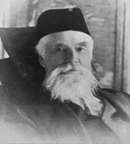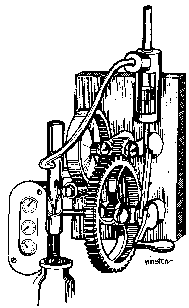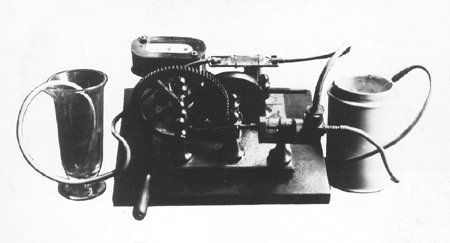 F.
E. Boericke and His Machine
F.
E. Boericke and His Machine F.
E. Boericke and His Machine
F.
E. Boericke and His Machine
Born in Glauchau, Saxony, Germany, Boericke emigrated to the United States in 1849, at age 23. In 1850 he met Rudolph Tafel, then 18, who was translating Le Boys des Guay's Letters to a Man of the World into German. Boericke was invited to assist in the work. In 1852, he formally joined the Philadelphia First Society, a New Church (Swedenborg) group.
In 1853 F. E. Boericke and Rudolph Tafel opened a book store that specialized in New Church (Swedenborgian) literature. At the urging of Constantine Hering, they added a homeopathic pharmacy to the business. Tafel left the business after about six months, assuming a teaching position at the Naval Academy in Annapolis, MD.
Deciding that he needed to learn more about homeopathy, F. E. Boericke enrolled at The Hahnemann Medical College of Pennsylvania, and graduated with an MD degree in 1863. He never practiced medicine. In the same year he married Elise Tafel, daughter of Dr. Leonard Tafel, and thus became a brother-in-law to Rudolph L., Louis H., and Adolph Tafel.
In 1869 he and Adolph formed the pharmaceutical company of "Boericke and Tafel."
In 1882 he retired from the pharmacy to run the "Hahnemann Publishing House," the publishing branch of Boericke and Tafel.
In 1887, he became an invalid "through a complication from a nervous disease."
He remained deeply involved with the New Church until his death. Said John Pitcairn in an obituary, "He had a wonderful memory, was a good conversationalist and even in his illness, when matters of the Church were discussed, he seemed to rise above his bodily sufferings."
It seems to me that the only legitimate way to prepare high potencies is to follow Hahnemann's method; or if anyone wishes to prepare high potencies according to his personal notions, he ought to abstain from giving his preparations the same numbers or designations as those prepared by the master's rule. I have, myself, carried many remedies to the 200th and my neighbor in business [A. J. Tafel] even to the 1000th potency. It is, of course, a very laborious process.
— extracted from Three Lectures on Homeopathic Pharmaceutics
published by F. E. Boericke in 1878.
Boericke says that he "made a machine" and made five remedies to the MM potency. These potencies were offered gratis in the Bulletin— a trade journal published by Boericke & Tafel. Boericke says, "No superiority nor any special claim was attached to the MM potencies. They were given out for whatever they might be worth."
 These
five were the only remedies produced on this machine. I have not been able to
find the identity of those five remedies, although one certainly was Lachesis—
since a record of a Boericke MM is reported by Dr. Berridge in the journal
The Organon (Vol. 1, 1878, page 347), and another was Sulphur —
which Berridge used, in an MM potency, to cure Thomas Skinner.
These
five were the only remedies produced on this machine. I have not been able to
find the identity of those five remedies, although one certainly was Lachesis—
since a record of a Boericke MM is reported by Dr. Berridge in the journal
The Organon (Vol. 1, 1878, page 347), and another was Sulphur —
which Berridge used, in an MM potency, to cure Thomas Skinner.
The machine was first pictured in Volume I of The Organon (1878, page 420), in an article by Thomas Skinner, MD.
With each turn of the crank, water is drawn from a vessel (not pictured) into the glass cylinder (seen at the right top) on the downward stroke of the piston. The upward stroke pushed the water out of the cylinder into the vial on the left. The vial was then given five shakes, and the next amount of water pushed the remaining water out the bottom of the vial.
A photo (seen below) of the machine, in a horizontal position is in my collection. It makes more sense being in a horizontal position, since the water would not flow out of the potentizing vial through the force of gravity but remain in the vial until it was displaced by the next measure of water that was fed into the vial. The photo is dated 1915. It is not known what happened to the machine.
Dr. Skinner, recounting how he became ill when he prepared high potencies of Cinchona and Kali carbonicum, suggested that Dr. Boericke's poor health might have been related to over-exposure to very high potencies during their preparation.

©2000 Julian Winston